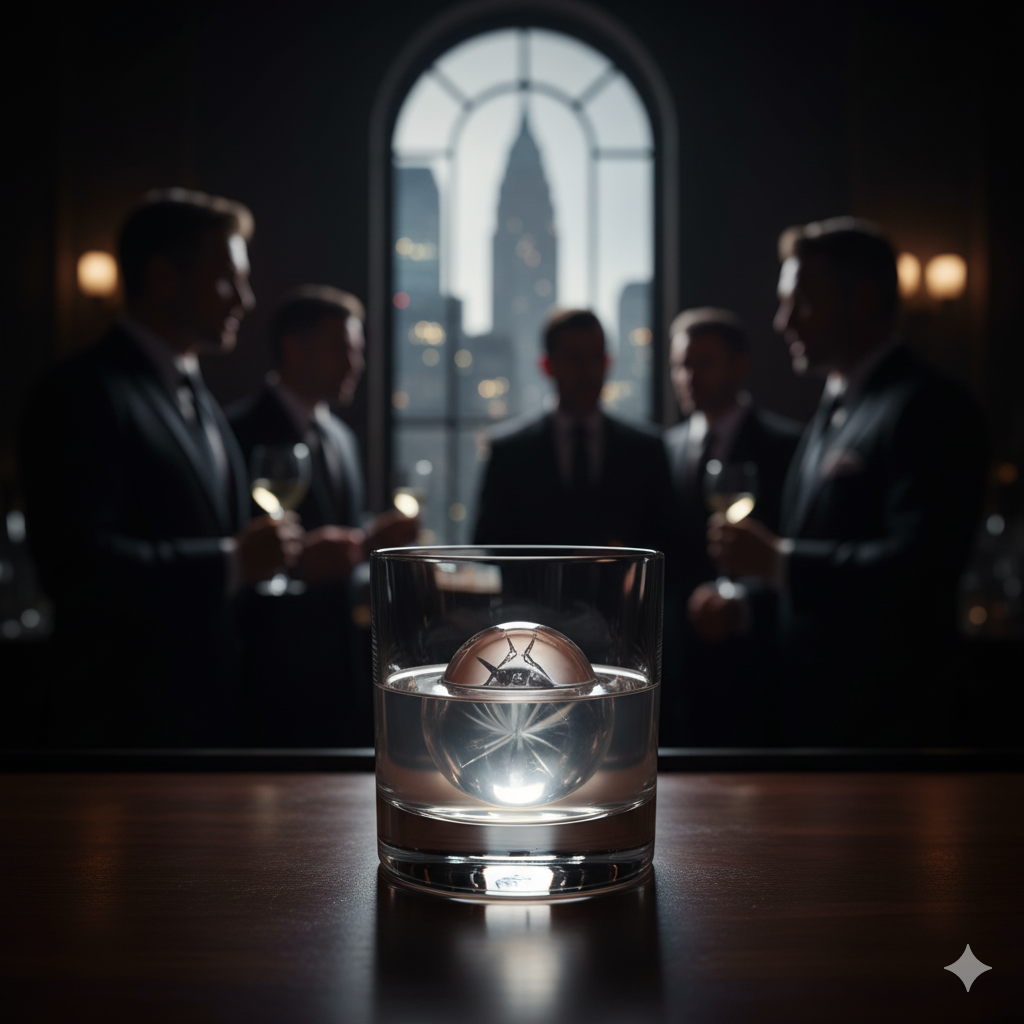The Gold Standard of Status: Armand de Brignac’s Brut Gold.
Moreover, this is not just a bottle; it’s a financial shibboleth, an economic filter separating those who have from those who merely wish they did. We are talking, of course, about Ace of Spades Champagne, known formally as Armand de Brignac Brut Gold. Therefore, we must ask: How does a new entrant, dominated by centuries of pedigree, justify a price point that triples its rivals?
The answer is a ruthless masterclass in the economics and psychology of status signaling. We must strip away the velvet rope and the celebrity endorsements to analyze the cold, hard financial utility of this conspicuously consumed bottle.
The Veblen Principle: Why the High Price is the Product
The entire premise of Ace of Spades Champagne rests on one foundational economic theory: the Veblen Good. Unlike standard commodities, demand for a Veblen good increases as its price rises. Conversely, most products see demand fall when prices increase. The price here is not a deterrent; it is the primary attraction.
This phenomenon is a direct critique of rational consumption. It shows the consumer is buying not juice, but distinction. Therefore, the $300 cost is not the expense of the wine; it is the tuition fee for admission to a highly visible, exclusive social club.
The Gold Shield: Loud Luxury for the Parvenu Class
Academics who study conspicuous consumption have a neat, four-part taxonomy for luxury buyers. The two groups at the top of the wealth spectrum are the Patricians and the Parvenus. Patricians, possessing old, quiet money, prefer ‘quiet luxury’—subtle products recognizable only by their peers.
Conversely, the Parvenus—wealthy but with a high need for status—use loud luxury to signal their arrival to everyone watching. The mirror-finish, gold-plated bottle of Ace of Spades Champagne is their definitive, non-verbal communication tool. It is impossible to miss. Furthermore, it is designed for a world where status must be instantly verifiable in a nightclub and, crucially, scannable for social media. A seminal study by the University of Southern California (USC) defines this brand prominence as a calculated choice to display wealth, which is precisely the Armand de Brignac strategy in practice.
The On-Trade Premium: A Margin Built on Envy
Analyzing the ultra-premium market shows that over 67% of sales occur in the ‘on-trade’ segment: hotels, bars, and high-end restaurants. Consequently, this distribution channel is where the status signaling reaches maximum efficiency. A restaurateur marks up a bottle of standard Champagne by 2.5x.
They can mark up an Ace of Spades Champagne by 4x, 5x, or even more, because they sell the experience of exclusivity at a premium. The customer, the Parvenu, pays this margin happily. Moreover, they know the high price ensures the bottle’s visibility—and thus their own—is magnified among their peers. This inflated on-trade price is not a business expense; it is a marketing investment in personal brand equity.
***
Exclusive Access for the Affluent Reader: Are your services tailored for the individual who understands the true value of conspicuous consumption?
Advertise with Social Life Magazine to reach the Patricians and Parvenus who drive the ultra-luxury market.
The Great Arbitrage: Substance Versus Signal
In finance, arbitrage is the simultaneous purchase and sale of an asset to profit from a price difference. In the luxury Champagne market, the consumer engages in a different kind of arbitrage: substance versus signal. We must look at the technical specifications of the product itself to understand the scale of the status premium. Armand de Brignac’s Brut Gold is a non-vintage (NV) blend of three vintages, aged for roughly three years on the lees.
Compare this to traditional rivals like Louis Roederer’s Cristal, a vintage cuvée aged for six years, often available at half the price. Therefore, by standard winemaking metrics, the classic rivals offer a higher technical product at a lower financial cost. A direct comparison confirms this financial anomaly. The premium, undoubtedly, pays for the signal, not the superior winemaking input.
The Cost of Rarity: Hand-Applied Pewter and Labor Scarcity
To defend the price point, Armand de Brignac crafts an impressive narrative of scarcity. They focus on the meticulous, low-volume production process. For example, each bottle is hand-finished with a French pewter label. Only 20 bottles can be completed per person per hour in the winery.
This is the ultimate luxury sleight-of-hand: the price is justified not by the time the liquid spent in the cellar, but by the manual labor required for the decorative armor. Moreover, the brand’s CEO notes that supply is on strict allocation, and growth is organic, emphasizing quality over quantity. Consequently, they are selling artisanal, high-touch packaging that protects a high-quality but otherwise non-vintage Champagne.
This focus on labor-intensive presentation transforms the bottle into a unique collector’s item, reinforcing the exclusivity. The narrative is clear: This bottle is rare because it’s expensive to make, and it’s expensive because we make it slowly and by hand.
The LVMH Model: Ownership and Uncompromising Quality
The brand’s strategic shift in 2021, becoming a joint venture with Moët Hennessy (LVMH), sealed its fate as an ultra-prestige house. This partnership provides access to the world’s most powerful distribution network. Furthermore, this affiliation legitimizes the brand’s valuation and confirms its enduring status as a luxury asset.
It’s no longer just a musician’s label; it is a meticulously positioned asset within the world’s largest luxury conglomerate. LVMH’s involvement ensures that the narrative of quality and exclusivity is globally enforced. This secures its position in the $13 billion global Champagne market, which is experiencing significant growth in luxury, experience-driven segments.
The Psychology of the Acquisition
The purchase of Ace of Spades Champagne is less about tasting notes and more about a psychological transaction. High-end consumers crave what they cannot easily have; the brand leverages this human instinct flawlessly. They use limited editions, like the Blanc de Noirs Assemblage, of which only 3,535 bottles were made.
Additionally, they offer the 30L Midas bottle—a mythical, special-order format—to cultivate a sense of scarcity and privilege. The psychology is clear: exclusivity drives desire. The Parvenu isn’t just buying Champagne; they are buying an entry pass to an elite group, a momentary relief from the fear of missing out (FOMO) on the apex of the social scene.
From Celebration to Investment: The Asset-Class Play
A further, clever layer in the Armand de Brignac strategy is the immediate pivot from celebratory drink to investment asset. They offer a meticulously crafted Ace of Spades Champagne La Collection—five cuvées in a set, just 300 cases existing globally. Consequently, the brand encourages HNWIs to view the bottle as a collectible, not merely a consumable.
This approach is a nod to a sophisticated audience. Furthermore, the brand’s commitment to high-level environmental standards (HVE level 3) subtly addresses the ‘Patrician’ concern for authenticity and provenance. They successfully bridge the gap between New Money flash and Old Money substance. Ultimately, they sell a financial narrative of scarcity that transcends the fizz.
The Social Media Utility and Status Validation
The ultimate economic utility of the gold bottle is its performance as a digital asset. The vibrant, metallic shell is perfectly optimized for the digital spotlight. Every cork pop, every tower of magnums, every Instagram story is free, hyper-targeted marketing.
Consequently, the buyer, the Parvenu, is paying a premium for a high-performance social proof engine. This is the genius of the entire operation: the bottle is the prop, the consumer is the distributor, and the $300 price tag is the cost of the guaranteed visibility. It is a perfect, self-sustaining loop of conspicuous consumption. Market data confirms the growing influence of social media trends on luxury consumption among younger, lifestyle-conscious consumers.
Conclusion: The Undeniable Moral of the Story
So, what is the raw, undeniable truth? The gold-plated bottle of Ace of Spades Champagne is not the best Champagne in the world; it is simply the most efficient status symbol in the ultra-premium drinking class. The $300 price does not reflect the quality of the non-vintage blend alone. Instead, it quantifies the desire of a specific, wealthy demographic to signal their ascendancy to all who observe.
Therefore, you are not paying for the wine; you are paying for the economic leverage the bottle provides. It is the perfect Veblen good: its value is not intrinsic, but a function of its cost, and its power is entirely in its visibility. For the ambitious Parvenu, this bottle is the cost of doing business at the highest level. You must ask yourself: how much is the undeniable feeling of having arrived truly worth?
Don’t Be a Follower. Be the Signal.
- Acquire: Secure Your Bottle of Ace of Spades Champagne Today and Define Your Table.
- Strategize: Consult Our Luxury Brand Strategists on the Next Investment in Your Personal Portfolio.
- Experience: Request an Invitation to Our Next Exclusive High-Net-Worth Event.
- Elevate: Subscribe to Social Life Magazine for Undiluted Access to the World of Luxury Economics.
Related Articles from Social Life Magazine






